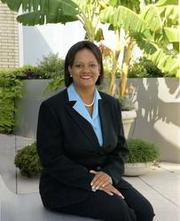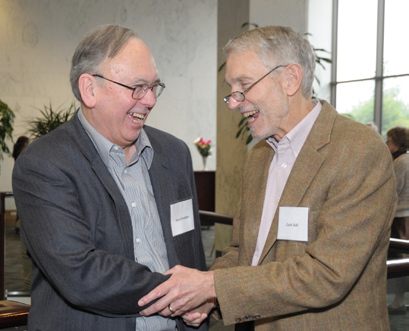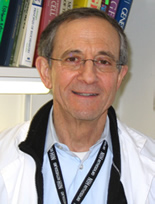Former NCMHD Council Member Benjamin Named ‘Genius’
By George Strait
 |
| Dr. Regina Benjamin, a past NCMHD advisory council member, was recently named a 2008 MacArthur Foundation fellow. |
Dr. Regina Benjamin, a past member of the National Center on Minority Health and Health Disparities advisory council and founder of the Bayou La Batre Rural Health Clinic serving a Gulf Coast fishing community in Alabama, has been named a 2008 MacArthur Foundation fellow. The so-called “genius” award provides $500,000 in no-strings support over the next 5 years.
Described by the foundation as a rural family physician who has forged an inspiring model of compassionate and effective medical care in one of the most underserved regions of the U.S., Benjamin said, “This wonderful honor really came as a total surprise. I was rushing out of the door that morning when I got a phone call from a total stranger who said I was being given $500,000 to do with as I wished!”
Bayou La Batre, Ala., is a village of about 2,500 residents. Hurricanes Georges (1998) and Katrina (2005) devastated it twice in the past decade. Despite scarce resources, Benjamin painstakingly rebuilt her clinic after each disaster and set up networks to maintain contact with patients who were scattered by the storms. Her family practice treats all incoming patients, many of whom are uninsured. She frequently travels by pickup truck to care for the most isolated and immobile in her region.
Benjamin, who attended Morehouse School of Medicine and received her M.D. in 1984 from the University of Alabama at Birmingham, is a skilled researcher as well. She is a member of the Dartmouth COOP Practice Based Research Network that translates research on preventive health measures into accessible, community-based interventions. She uses these techniques to decrease the disease burdens of her diverse patient base—immigrants from Vietnam, Cambodia and Laos, who comprise a third of Bayou La Batre’s population. She served on NCMHD’s advisory council from 2003 to 2007.
“We at NCMHD could not be more proud of Dr. Benjamin or more pleased that her great work has been recognized in this way,” said Dr. John Ruffin, NCMHD director. “For this quiet leader, the genius of her work lies in the choices she has made: to serve the underserved, to be a voice for those who have none and to work tirelessly to develop ways to eliminate health disparities.”
So what is Benjamin going to do with the money? “I simply want to make a difference with it,” she said. First, she is designing a pipeline project: scholarships of $500 each for 4 students a year, to encourage them to go into health careers. The project will focus on sixth graders with the scholarship being presented at their sixth grade graduation ceremony. “This means a lot to rural and minority kids and their parents,” said Benjamin. “Also the program builds off ideas on how to eliminate health disparities that I was proud to be part of when I was on NCMHD’s council.”
Tompkins To Lead NIGMS Branch
Dr. Laurie Tompkins is the new chief of the Genetic Mechanisms Branch in the NIGMS Division of Genetics and Developmental Biology.
She has been a program director in the branch since 1999. Before then, she was a professor in the Temple University department of biology, where she conducted NIH- and NSF-funded research on the genetics of Drosophila reproductive behavior.
The Genetic Mechanisms Branch supports basic research in areas ranging from DNA replication, recombination and repair to population genetics and evolution.
“Dr. Tompkins has a wealth of knowledge about basic genetics, a deep appreciation of the issues facing the extramural scientific community and a broad understanding of NIGMS and NIH policies and practices,” said division director Dr. Judith Greenberg. “These strengths will serve her well in leading the branch and charting its future directions.”
In addition to leading the branch and managing grant portfolios in the areas of transcription and behavioral genetics, Tompkins will continue to serve as NIGMS coordinator for genomics resources for model organisms and to represent NIGMS on the NIH Neuroscience Blueprint and zebrafish coordinating committees. She will also maintain her role in the trans-NIH EUREKA initiative, which she co-designed as a new way to fund exceptionally innovative, potentially high-impact research.
In recent years, Tompkins has participated in a variety of other activities, including the STEP program and the genomics working group. In 2005, she worked with the State Department and the Postal Service to change a postal law that prevented the shipment of Drosophila cultures from one country to another.
Tompkins earned a Ph.D. in biology with a concentration in genetics from Princeton University. She conducted postdoctoral research in neurogenetics in Dr. Jeffrey Hall’s laboratory at Brandeis University. She has received two NIH Director’s Awards and several honors recognizing her skill in communicating science to lay audiences and her teaching ability. She is a fellow of the American Association for the Advancement of Science and a member of the Genetics Society of America.
OACU Chief Taylor Says Goodbye at Retirement Party
By Jan Ehrman
Surrounded by 80 well-wishers, including family, colleagues and friends, Dr. James F. Taylor, director of the Office of Animal Care and Use (OACU) for the past 17 years, said goodbye to NIH at a retirement reception held Dec. 5 at the Cloister, Bldg. 60.
Taylor directed the office that provides regulatory and policy guidance on the appropriate and humane use of animals in research. A veterinarian, he received board certification in laboratory animal medicine in 1975. He graduated from Ohio State University’s College of Veterinary Medicine and earned a master’s degree in radiation biology from the University of Rochester.
Upon graduating from college, Taylor joined the Army and assumed positions overseeing animal care and the safe use of animals in military research laboratories. During his time with the armed forces, he was stationed for 2 years in Taiwan, an experience he calls “exhilarating.”
Drawing upon and following his service experience, Taylor joined NIH and OACU in 1988, becoming its director 3 years later. His staff acknowledges and appreciates his myriad accomplishments.
“Through his many years as the OACU director, Dr. Taylor has touched thousands
of individuals with his hands-on manner and willingness to share his thoughts, opinions and knowledge,” said Dr. Terri Clark, deputy director of OACU. “He has single-handedly shaped the knowledge and abilities of many individuals that have supported animal research within the intramural program over these years.”
Present at the reception were Dr. Michael Gottesman, NIH deputy director for intramural research, and his assistant Dr. Richard Wyatt, both of whom expressed their gratitude and appreciation for Taylor’s tremendous contribution to NIH’s Intramural Animal Program and to ensuring that the agency met the highest standards in the welfare of animals in the research setting. A number of chairpersons from the animal care and use committees and animal program directors from various institutes, with whom Taylor worked closely over the years, also attended.
Taylor was presented with a sterling silver key ring and tie tack bearing the OACU logo. In addition, in recognition of his passion for fast cars, friends and colleagues handed him a certificate enabling the auto buff to drive 10 laps around Dover International Speedway in an authentic race car.
In retirement, Taylor, a Derwood resident, also hopes to pursue some of his other hobbies including photography, using computers and listening to music. He said he may also do some traveling with his wife of 47 years, Patti, whom he refers to as “his greatest support.”
NIAMS's Austin Receives ARHP Honor
Dr. Janet Austin (l), director of the NIAMS Office of Communications and Public Liaison, received the Addie Thomas Service Award from the Association of Rheumatology Health Professionals at its annual scientific meeting in San Francisco recently. The award, presented in honor of ARHP’s first president, recognizes individuals who have volunteered with local, regional and national arthritis-related activities. Austin has been a member of ARHP for 20 years and has served in a number of leadership positions including as chair of the program subcommittee. She is nationally recognized in the rheumatology community as a motivational speaker, combining her personal experience with rheumatoid arthritis with a professional commitment to improving the lives of people affected by rheumatic diseases. Joining her in the photo is NIAMS director Dr. Stephen Katz.
ORS’s Wilson Wins Wedum Award
Dr. Deborah Wilson, director of the Division of Occupational Health and Safety, ORS, won the Arnold G. Wedum Distinguished Achievement Award from the American Biological Safety Association at its annual Biological Safety Conference in Reno recently. The award is given to a current ABSA member for outstanding contributions to biological safety accomplished through teaching, research, service or leadership. The association cited Wilson’s work with the WHO Collaborating Center for Applied Biosafety Research and Training; she is directing the training of laboratory workers throughout the world on biosafety principles and practices.
Zach Fest’
NINDS Honors Past Director Hall
 |
| Former NINDS director Dr. Zach Hall (r) is greeted by Dr. Stan Froehner of the University of Washington
during Zach Fest. |
More than 100 friends, family and colleagues attended Zach Fest, a symposium celebrating the career of past NINDS director Dr. Zach Hall at the Lister Hill Center recently. Hall spent most of his career as a neuroscientist at the University
of California, San Francisco (UCSF), and Harvard, and was director of NINDS from 1994 to 1997.
Other noteworthy positions in his career included: head of the UCSF neuroscience program;
chair of UCSF’s department of physiology;
co-founder of its program in biomedical science; UCSF
vice and executive vice chancellor of research; senior associate dean and director of the Zilkha Neurogenetic Institute at the Keck School of Medicine, University of Southern California;
and president of the California Institute of Regenerative Medicine.
Throughout his career, Hall’s research focused on the molecular function and development of the neuromuscular junction as a prototype of synapses in the brain. He was one of the founding
editors of the journal Neuron and wrote and edited a widely used textbook, An Introduction to Molecular Neurobiology.
In recognition of his contributions to biomedical
research training, the Zach W. Hall Student Award Fund has been established in the Neuroscience
Institute at Morehouse School of Medicine.
The purpose is to continue Hall’s legacy of outreach and student support at Morehouse.
NHLBI’s Pohl Wins Toxicology Award
 |
Dr. Lance R. Pohl, chief of the section on molecular and cellular toxicology in NHLBI’s Laboratory of Molecular Immunology, is the recipient of the Society of Toxicology’s 2009 Distinguished Toxicology Scholar Award. For more than 30 years, he has been a leader in the field of drug toxicity. His work on the anesthetic halothane established the association between biotransformation, covalent adduct formation and immune response with idiosyncratic hepatotoxicity. His laboratory has also made several other major contributions to the field of toxicology, including the development of innovative techniques for identifying highly reactive and toxic metabolites of drugs and other xenobiotics that are produced by cytochrome P-450s and other hemoproteins and the first design and use of specific antibodies for exploring the identity and toxicologic consequences of in vivo protein adducts of hepatotoxic drug metabolites. In more recent years, he and his colleagues have used animal models to identify numerous cytokines and other factors that determine susceptibility to drug-induced liver injury.